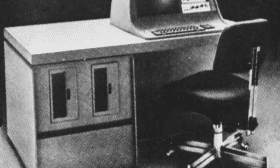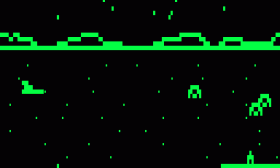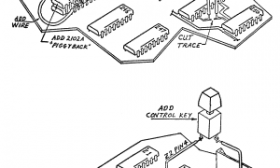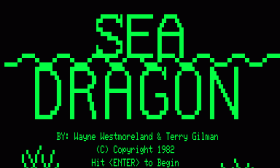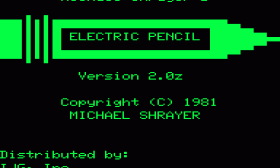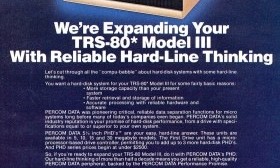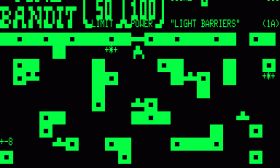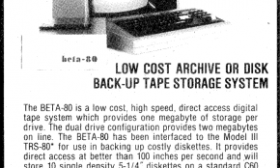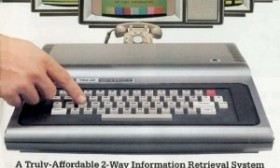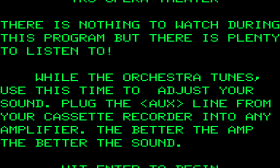The Tandy 10 was the second computer introduced by Radio Shack, although it wasn’t part of the TRS-80 line. It was actually manufactured by Applied Digital Data Systems, also known as ADDS. ADDS (which still exists today as Boundless Technologies) was the largest independent supplier of video display terminals at the time. Unlike the TRS-80 computers, the Tandy 10 was branded using the Tandy name (Radio Shack’s parent company) rather than Radio Shack.
First offered in 1978, the Tandy 10 (catalog number 81-2110) was actually the ADDS System 50, a variant on the earlier System 70. Described as a workstation, the Tandy 10 was clearly targeted at businesses. It had a good set of features for a computer at that time:
(Read more...)
The Eliminator, distributed by Adventure International, was an adaptation of the arcade game Defender, released by Williams Electronics in 1980. Adventure International sold The Eliminator (the definite article “the” was part of the title) for several computers:
- the TRS-80 version, written by Wayne Westmoreland and Terry Gilman, was released in 1981
- the Apple II version, written by John Anderson, was also released in 1981
- the Atari 400/800 version, written by Steve Coleman, was released in 1982
Here is the description of the TRS-80 version of The Eliminator from a 1981 Adventure International catalog:
(Read more...)
The best known limitation of the TRS-80 Model I was its inability to display lower case characters. Although the lower case characters were present in the character set, the Model I lacked the extra memory chip needed to store the bit corresponding to lower case.
The significance of this limitation has been exaggerated over time (it’s worth noting that the contemporary Apple II also lacked lower case), but it created a real problem for word processors. There were many lower case upgrades for the Model I designed to fix the omission, ranging from simple to more complex.
One of the simplest modifications was commonly referred to as the Electric Pencil lower case modification. It was first detailed in 1978 in the manual for the TRS-80 version of the Electric Pencil word processer, for which it was designed. It quickly became the de facto standard for lower case upgrades and was widely reprinted elsewhere. Several companies, including Microtronix, sold the parts and instructions for the modification as a kit.
(Read more...)
Sea Dragon, written by Wayne Westmoreland and Terry Gilman, was one of the most popular games for the TRS-80. It was released in 1982 by Adventure International, which also sold versions for other computers:
- the Apple II version, written by John Anderson, was released in 1982.
- the Atari 400/800 version, written by Russ Wetmore (Star Systems Software), was released in 1982.
- the TRS-80 Color Computer version, written by Jim Hurd (Coniah Software), was released in 1983.
- the IBM PC version, written by Dan Rollins, was released in 1983.
- the Commodore 64 version, written by David H. Simmons, was released in 1984.
Along with Time Bandit and Arex, Sea Dragon was the TRS-80 game that was adapted to the greatest number of computers.
(Read more...)
Electric Pencil (also known as The Electric Pencil) was the first word processor written for a microcomputer. The original version was created by Michael Shrayer and released for the MITS Altair in December 1976. The TRS-80 version was released almost two years later and it dominated the market until the introduction of Scripsit.
Electric Pencil was one of only five pieces of software inducted into the 80 Micro Hall of Fame in 1983, with the panel stating that Electric Pencil “demonstrated conclusively that a TRS-80 could be used for serious word processing, and was the model for later word processors.”
(Read more...)
The Percom PHD was a line of 5 1/4" Winchester hard drives sold by Percom Data for the TRS-80 Model III, as well as several other computers. Introduced by Percom in 1982, the PHD used what was described as a “smart microprocessor-based drive controller” to allow up to four PHD drives to be connected to the Model III at one time. The Model III version also worked with the Model 4, but Percom never sold a version for the Model I.
The PHD drives were available in 5, 10, 15, and 30 megabyte sizes. The model numbers corresponded to the drive capacity: the PHD-10 was a ten megabyte drive. The prices started at $2,495.00 and increased with drive size.
(Read more...)
Time Bandit, written by Bill Dunlevy and Harry Lafnear, was a TRS-80 Model I/III game first released by Computer Shack in 1983. Computer Shack (which changed its name to Michtron in 1984) also released versions of Time Bandit for a number of other computers:
- the TRS-80 Color Computer (also released in 1983)
- the Sanyo MBC-550 (released in 1984)
- the Atari ST (released in 1986)
- the Amiga (released in 1988)
- the IBM PC (released in 1988)
The Atari ST and Amiga versions in particular remain quite highly regarded today.
(Read more...)
The BETA-80 was an “intelligent” cassette tape system that could store up to one megabyte on a single digital tape cassette. It was sold by MECA as an alternative to an Expansion Interface and disk drives. MECA sold versions of their digital tape systems for a number of computers using different names:
- BETA-80 for the TRS-80 Model I (and later the Model III)
- TAPE-II for the Apple II
- BETA-EX for the Exidy Sorcerer
- ALPHA-1 for S-100 computers
(Read more...)
In the early 1980’s, many people thought that interactive computer services over the telephone would be the “next big thing.” TRS-80 VIDEOTEX was Radio Shack’s solution for accessing centralized information services such as CompuServe, The Source, the Dow Jones Information Service, or custom VIDEOTEX services. It was described as “two-way information retrieval system for home or office use.”
Here’s a description of TRS-80 VIDEOTEX from a 1981 Radio Shack catalog:
(Read more...)
TRS-Opera, written by Richard Taylor, was an early TRS-80 music program. It was distributed by Acorn Software and sold for $9.95.
TRS-Opera is a BASIC program with an embedded machine language sound routine. The sound routine plays notes through the TRS-80 cassette port very rapidly, simulating more than one note at a time. The “opera” part of the name derives from the choice of music included with the program:
(Read more...)
